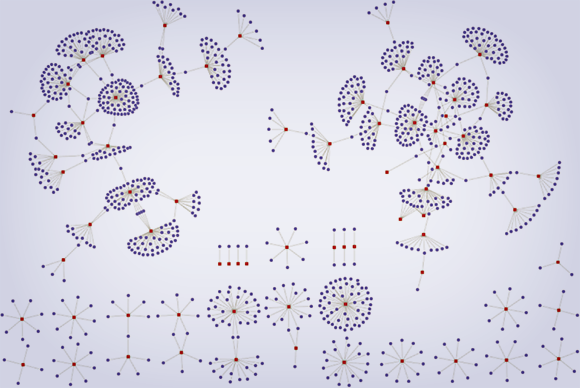July 20, 2016
During the collapse of the Soviet Union, tens of thousands of sealed radioactive sources were abandoned in the former Soviet republics. These orphan and legacy sources, originally intended for use in fields such as cancer treatment, sterilization, seed irradiation, and weld testing, pose a wide range of threats, from public safety to domestic and international security. These risks were illustrated in early 2015, when criminals attempted to sell a cesium-137 source to undercover Moldovan police officers posing as Islamic State middlemen.

Network graph of the CNS-produced database.
The James Martin Center for Nonproliferation Studies has partnered with the Moldovan National Agency for Regulation of Nuclear and Radiological Activities (NARNRA) for a unique, first-of-its-kind project to locate and track radiological sources using new media tools. NARNRA provided CNS with a list of 101 facilities known or suspected of working with or hosting radioactive sources. CNS used this list to locate current and former employees of those facilities through data analysis. In cases where original records no longer exist, the knowledge of these individuals can play a key role in recovering orphan and legacy sources.
Traditionally, finding employees is a time-consuming process requiring inquiries, negotiation, travel, and review of paper records. Instead, CNS researchers used targeted internet searches, database software, and network analysis tools to find the social media accounts of people associated with the facilities. Within three months of receiving the facility list, CNS produced a database of over 1,000 people associated with seventy-two targeted facilities, and provided NARNRA with a list of twenty-five people with the highest network centrality. Theoretically, these people should have the most connections with former co-workers. As such, they should be well positioned to provide NARNRA with the desired information, or to be connected to someone who can.
The next phase of the project will focus on developing a protocol for contacting and interviewing the current and former employees. If successful, this project could serve as the prototype for future work elsewhere in the former Soviet Union and beyond, as it represents a significant reduction in the work, cost, and time involved in locating and recovering orphan sources.
This project is funded by a grant from the Skoll Global Threats Fund with support from the Swedish Radiation Safety Authority.
